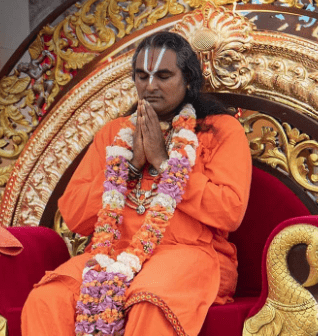What is Bhakti-yoga?
‘One is simply elevated by the nine forms of bhakti and all forms are connected with the glories of the Lord, and are the ways to connect, develop, and deepen our relationship with Him.’
- Paramahamsa Vishwananda
Bhakti means devotion or action out of love for the sake of love only. There are infinite ways this inner love can be externally expressed. Yoga means union. Bhakti-yoga is union with God through unceasing single-pointed focus and devoted actions out of deep love for Him. The goal for those on the path of devotion is to develop a loving personal relationship with God. As such, this union does not mean merging with God but living constantly in awareness and engagement with that relationship.
Practising bhakti-yoga requires us to learn how to drop the obstacles and barriers that our mind has created and built up against this love. It pushes wide open the gates to eternity inside of us.
The Nine Forms of Bhakti
Prahlad Maharaja said: Hearing and chanting about the transcendental holy Name, form, qualities, paraphernalia and pastimes of Lord Vishnu, remembering Him, serving the lotus feet of the Lord, offering the Lord respectful worship with sixteen types of paraphernalia, offering prayers to the Lord, becoming His servant, considering the Lord one’s best friend, and surrendering everything unto Him (in other words, serving Him with the body, mind and words) — these nine processes are accepted as pure devotional service. One who has dedicated his life to the service of God through these nine methods should be understood to be the most learned person, for he has acquired complete knowledge.'
- Srimad Bhagavatam, 7.5.23-24
The nine forms of bhakti are shravana, kirtana, smarana, padaseva, archana, vandana, dasya, sakhya, and atmanivedana. These nine forms are embodied in the nine techniques in Atma Kriya Yoga and are awakened when the techniques are sincerely practised. But there are other ways to practice them as well.
Let’s get into what each form is and how to practice them.
Shravana-Bhakti

Listening can influence you in a positive or not-so-positive way. Therefore, it is important to listen not just to anything but to the glories of God. Shravana-bhakti arises when you read and listen to the stories and glories of God or the saints. It allows you to get to know God and live the stories of God, the saints, and their relationship vicariously.
When your mind is absorbed in hearing, imagining, and assimilating the stories, a deep impact is made. It brings about a great transformation inside of you.
The same also happens when we do japa. Japa is the continuously repeated chanting of the name of God in the form of a mantra. It is a vital and foundational spiritual practice in Bhakti Marga and bhakti-yoga, in general. Through sincere practice, you can tune into the vibration of the mantra, awaken to the unlimited cosmic love and experience the presence of God in your daily life.
Project Mantra is a free and easy tool to help you start and establish a daily japa practice. Other ways to experience shravana-bhakti are reading the holy scriptures like the Srimad Bhagavatam, reading about the lives of saints, listening to satsangs, and even sharing your experiences on the spiritual path with others.
Kirtana-Bhakti
Kirtana-bhakti arises when singing the glories of God. Normally this is done in a group. When you sing you also use your whole body by playing instruments, clapping, and dancing. In doing so, the mind becomes calm and the internal love begins to radiate externally. It is very joyful and everyone moves along in the direction and positive vibration of the group.
When you sing the glories, you should do it without any motive or personal gain. Just sing for God and aim to please Him. Pour your heart out whilst singing. You need not compete with others about your voice or how you play instruments. Sing along to a kirtan instead of listening to the radio whilst driving. Sing while doing chores at home. Be in the moment and sing freely from your heart in any manner you desire. Sing like it's just you and God alone. In no time, you will get to the place where you can sing with others for God without a worry about what they may think of you.
Smarana-bhakti
Smarana-bhakti is the constant remembrance of God. The more you hear about Him and sing His glory, the more you will want to be in His company. Then the more you will be in constant remembrance of Him throughout the day.
This state is attained when the mind is purified and unattached to the world. The mind, when letting go of the world, naturally helps us remember God at all times. You look inside of yourself to find that love and see yourself as part of the source of that love. The mind becomes attached to God alone.
Bhakti-yoga can be very practical. A great way to develop the constant remembrance of God could be keeping a photo or an item that will trigger a memory of your experience with God nearby or on your desk at work or home. It could be a screensaver you see on your computer, a profile photo on your phone you see when picking your phone to make or receive a call, or even playing a recording of om namo narayanaya on repeat throughout the day as you sit at your desk. Even consider beginning and ending every activity with a prayer. Living in this way will help to remind you of God and how He is always with you all the time.
Padaseva-bhakti
Padaseva-bhakti means service to the Lotus Feet of the Divine. God is also present in everyone's hearts and so serving the divinity in others is also padaseva-bhakti. We see others as a part of God with their own unique relationship with God. By serving the relationship others have with God, you are not only serving God but also your relationship with Him. Service should be done with love, offering the fruits of your efforts to the Lord.
When you do this, your focus gradually moves from the expectations of what you may receive to the joy of serving and giving.
Devotees of Paramahamsa Vishwananda offer service to Him and His mission. The reason being, that as a satguru He guides them towards attaining God, and without this guidance, it would be impossible to attain God.
By keeping the Lord in your mind, you can serve in three different ways: on your own, in a community, or for the world. Serving on your own could be through your daily Atma Kriya Yoga or japa practice, which, in addition to transforming you, also emits love and positivity to your surroundings. It could be through financial contributions or even actively sharing what you've received. Serving in a community can be giving your time to help organize events or by cleaning the community temple or centre which is frequented by all. Serving the world can be by participating in OM Chanting circles when you chant to heal the people present in the circle, the people we are praying for, and Mother Earth herself.
Archana-bhakti

Archana-bhakti is the devotion that awakens from the external worship of the divine in ceremonies and rituals. We first establish a relationship with the unlimited Divine present in the form of a deity on the outside. This leads us to a relationship with the same form of the Divine within us. The deep connection between the deity outside of you and within you is very much present and the feeling of the heart knows about it even if the mind does not see it. With time, you learn to worship God inside of you.
Although the ways of ritual or ceremonial worship may vary from one tradition to another, their importance cannot be disregarded in any way.
Vandhana-bhakti
Vandana-bhakti means bowing down or physical prostration. The mind and the body are connected, so when you bow down your brain and your head come to the level of your physical heart or even lower. It creates humility in us. Bowing to the Feet of the guru or deities in the temple is very humbling.
Humility is one of the most essential things on the spiritual path because, without humility, you can’t learn anything from anybody. If humility is something that you feel you need to work on, practice the asanas shared in Atma Kriya Yoga or do some self-analysis around it.
Vandhana-bhakti is also where you realize your limitations and the need for help in your spiritual journey from a true guru or satguru, who has mastered the way to the end of the journey. By bowing down we accept that the guru is someone who can lift us higher than the level we can attain by ourselves. With this in mind and at heart, you accept the satguru’s instructions with full obedience.
Some other ways to nurture humility include proactively seeking feedback to gain an awareness of your attitude, setting aside your defensiveness, focusing on empathy, being grateful to God, taking time to listen to others, being willing to learn from others, and thinking more about others than you think about yourself.
Dasya-bhakti
Dasya-bhakti is direct service to God. In this form of bhakti-yoga, everything that you do is in servitude to God. For example, when you are washing the dishes, you see it as a service to God. Washing God’s dishes is not just simply washing the dishes. You surrender your energy in the pursuit of pleasing God and guru. It can be cleaning your house, working in the office, sweeping the temple floors, and also any task that the guru has asked you to do. You slowly start to let go of your ego-self for God and guru and direct all your energy towards God and guru.
Sakhya-bhakti

Sakhya-bhakti is the personal relationship between you and God. It is a special relationship that is unique to each one and which no one else will ever have.
As sahkhya-bhakti grows, the love relationship between God and the bhakta becomes the most important thing. The pleasure of the God and guru is placed above any other external service. Over time all the rules and rituals fade away and love becomes the only service. There is no other desire than to have a personal love relationship with guru and God. Many saints experiencing sakhya-bhakti have a relationship with God as their friend.
Atmanivedana-bhakti
Atmanivedana-bhakti is the knowledge of the essence of the soul or self-realisation. It is the state in which we are always in God-consciousness. The love relationship becomes so intense that it is the only thing that remains for bhakta. Your soul identity is completely surrendered to God. This can only be given by the grace of God and the guru. It is not attainable with your effort.
A few months into practising Atma Kriya Yoga, I became a devotee of Paramahamsa Vishwananda. The prophecy from the lady dressed in orange, radiating love and joy, did come true just a few months after that. I sang and danced joyfully in public for guru and God. And I am glad I did so.
How did I not see the joy in doing so then? The many barriers and obstacles that I had put up for myself against expressing and experiencing this love had been in the way.
‘When you dive into that bhakti itself, then you will know what pull, what current that devotion has. And when you dive, you don’t think whether you can swim or not. Let yourself be drowned in it. The current will carry you.’
-Paramahamsa Vishwananda
You do not have to run away to a cave or an ashram to become a yogi. Learning to live spiritually, no matter where you are, is a key part of spiritual advancement and transformation. Learn how with our free guide on living spiritually in the material world.








